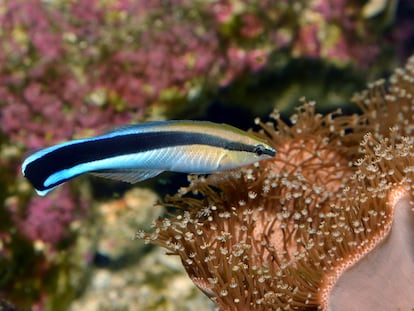Personality tests guarantee successful conservation of wild animal populations
Programs to reintroduce locally extinct species are increasingly taking into account the behavior of the individuals being released

The swift fox (Vulpex velox), which is native to North America, was declared extinct in the state of Montana in 1969. In response, different organizations reached an agreement to begin a reintroduction program that established a population of foxes on the Blackfeet Indian Reservation in northern Montana. Thirty years after their extinction, the first individuals were released, and the reservation once again saw swift foxes running across its plains. This program not only managed to successfully recover this species, but also marked a before and after for conservation. For the first time, it had taken into account the personality of the animals that were released.
Today, there is no doubt that animals — even fish and invertebrates such as crustaceans — also have a personality, which is defined by the differences in the behavior of individuals of the same species. These differences have to be constant over time and in different situations or contexts. In the same way that there are people who tend to be braver, more sociable, or more aggressive than others, these personality traits have also been observed in other species. Currently, the study of animal personality is one of the fastest growing fields in biology and has very interesting applications. One of these is in the field of conservation and especially in species reintroduction.
Every reintroduction program worth its salt includes a thorough evaluation of the process. If this does not happen, we are simply talking about releasing animals or something else, but not about reintroduction. The programs carry out studies to ensure that the animals meet appropriate health and behavioral criteria to survive in the wild, such as being able to find their own food or flee from predators. Furthermore, after release, the animals are monitored for months or even years and the reintroduction is only considered a success if they reproduce and manage to create a stable and long-lasting population.
The scientists in charge of the swift fox reintroduction wanted to go further and also studied whether the foxes’ personality affected their survival in the wild. They decided to focus specifically on one trait: bravery. The foxes came from a captive colony, where personality tests could be applied. To carry out their experiment, they introduced a new object into the animals’ enclosure and measured the time it took each individual to approach it.
Those foxes that were repeatedly more likely to explore new stimuli were considered braver. Thus, they evaluated 31 individuals for two months who were then released. The results were overwhelming: the brave foxes died before the cautious ones.
According to the authors of this research, it is possible that captive foxes were less fearful than would be appropriate for a wild fox. Stress affects reproduction, therefore, those individuals that are less stressed in captivity (because they are less fearful) will reproduce more. After several reproduction cycles, it is expected that the new generations of these foxes will be less afraid of new stimuli. Thus, upon returning to their natural habitat, they explore the territory more and avoid cars less, which makes it easier for them to die from being run over. At least, this was the case for the only two deaths whose cause could be determined. Thanks to this research, it was possible to recognize the importance of considering the personality of animals in conservation efforts.
Since then, other reintroduction programs have included personality studies. In particular, aspects such as daring, courage and sociability are taken into account. For example, to reintroduce social species, conservationists seek to have a wide variety of personalities among individuals, because it makes coexistence easier. This is what is proposed by the social niche specialization hypothesis, which is corroborated by a variety of studies in species such as shrews, spiders, and fish.
Now, if one clear conclusion can be drawn from all these studies, it is that there is immense variability in the results. Even within the same species, the optimal personality for survival might be different depending on the environment and time. Braver individuals are more likely to take risks and may die sooner, but they also reproduce and take over new territories faster. Each trait has advantages and disadvantages, and the balance can easily tip one way or the other depending on the circumstances.
The 'game' of survival
A clear example is the European mink reintroduction program in Estonia, which evaluated the survival capacity of these animals based on their propensity to explore new territories. Curiously, at the beginning the less exploratory individuals were more successful, but within a year the tables had turned. This could have been due to external factors, such as variation in the abundance of prey, or because the second year was drier and warmer. The important thing is that the population remained stable over time, thanks to the fact that the personality of the minks was varied.
Some authors have suggested that animal personality differences can be explained by what is known as game theory. Suppose a population of animals in which the most aggressive individuals win fights against the more docile animals and reproduce more. In this case, being aggressive would be an advantage and, over time, the population would be dominated by this type of individual. There would come a point when fights would be so frequent and deadly that the tables could be turned. Those animals that are more timid and peaceful would engage in fewer conflicts and be more likely to survive. In this way, evolution favors some personality traits or others in nature, and diversity is maintained over time.
The relationship between an animal’s personality and its ability to survive is extremely complex, and this field of study still has a lot of potential. Each reintroduction program will have to find the ideal personality types to guarantee survival in the wild for as long as possible. At a time when species are becoming extinct faster and faster, any small push towards conservation is helpful.
Sign up for our weekly newsletter to get more English-language news coverage from EL PAÍS USA Edition
Tu suscripción se está usando en otro dispositivo
¿Quieres añadir otro usuario a tu suscripción?
Si continúas leyendo en este dispositivo, no se podrá leer en el otro.
FlechaTu suscripción se está usando en otro dispositivo y solo puedes acceder a EL PAÍS desde un dispositivo a la vez.
Si quieres compartir tu cuenta, cambia tu suscripción a la modalidad Premium, así podrás añadir otro usuario. Cada uno accederá con su propia cuenta de email, lo que os permitirá personalizar vuestra experiencia en EL PAÍS.
¿Tienes una suscripción de empresa? Accede aquí para contratar más cuentas.
En el caso de no saber quién está usando tu cuenta, te recomendamos cambiar tu contraseña aquí.
Si decides continuar compartiendo tu cuenta, este mensaje se mostrará en tu dispositivo y en el de la otra persona que está usando tu cuenta de forma indefinida, afectando a tu experiencia de lectura. Puedes consultar aquí los términos y condiciones de la suscripción digital.
More information
Archived In
Últimas noticias
Most viewed
- Reinhard Genzel, Nobel laureate in physics: ‘One-minute videos will never give you the truth’
- Oona Chaplin: ‘I told James Cameron that I was living in a treehouse and starting a permaculture project with a friend’
- Pablo Escobar’s hippos: A serious environmental problem, 40 years on
- Charles Dubouloz, mountaineering star, retires at 36 with a farewell tour inspired by Walter Bonatti
- Why we lost the habit of sleeping in two segments and how that changed our sense of time











































